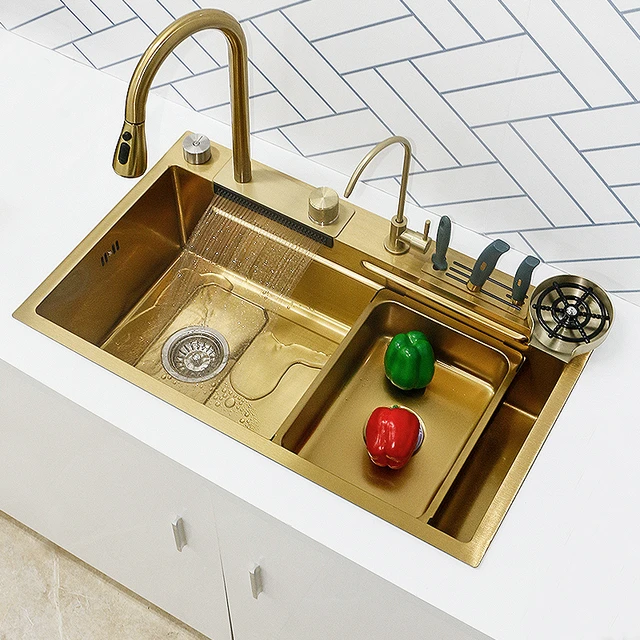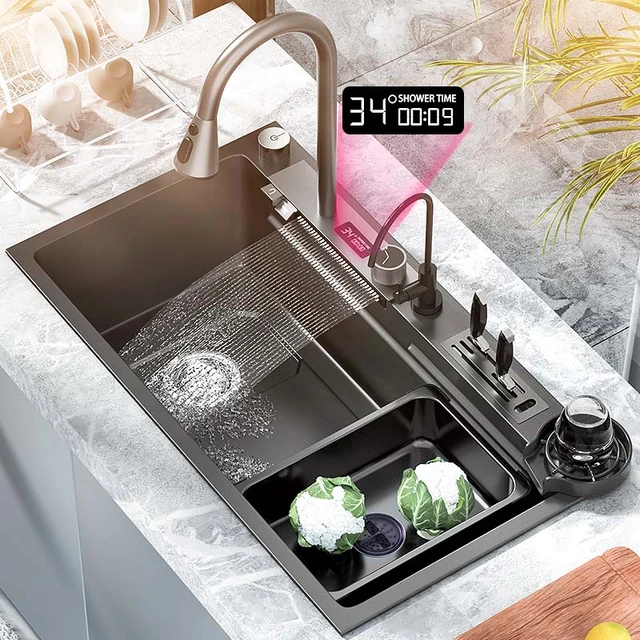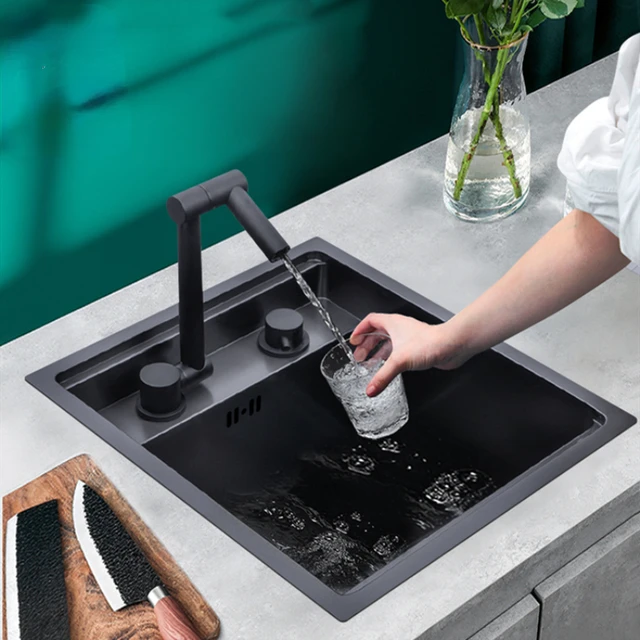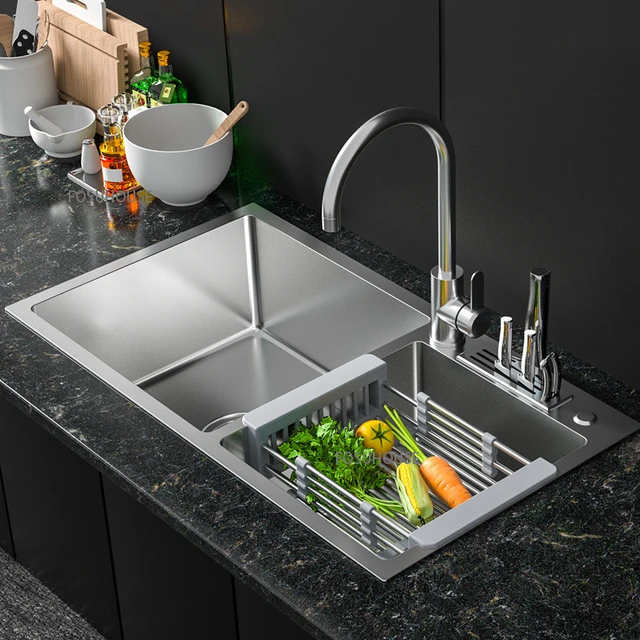Introduction
The size of a kitchen sink is an important consideration when renovating or designing a kitchen. It affects the functionality, workflow, and overall aesthetics of the space. While the standard sink size is commonly used, not all kitchen sinks are the same size. In this comprehensive overview, we will explore the various sizes of kitchen sinks, including standard dimensions and considerations for different types of sinks and installation options.
Are all kitchen sinks the same size?
I. Understanding Standard Sink Sizes
-
Standard Double Bowl Sink:
- The most common size for a standard double bowl sink is approximately 33 inches in length, 22 inches in width, and 8-10 inches in depth. Each bowl is usually around 14-16 inches wide.
-
Standard Single Bowl Sink:
- Standard single bowl sinks typically measure around 25-30 inches in length, 22 inches in width, and have a depth of 8-10 inches.
-
Bar/Prep Sink:
- Bar or prep sinks are typically smaller, measuring around 15-18 inches in length, 15-18 inches in width, and 5-7 inches in depth. These sinks are designed for smaller tasks or in areas where space is limited.

II. Types of Kitchen Sinks and Their Sizes
-
Undermount and Top Mount Sinks:
- Undermount and top mount sinks come in various sizes, ranging from small bar sinks to standard double or single bowl sizes. The size of these sinks depends on personal preference, available space, and intended use.
-
Farmhouse/Apron Sinks:
- Farmhouse sinks are known for their large, deep basins. They typically range from 30 to 36 inches in length, 20 to 24 inches in width, and have a depth of 8-10 inches. However, they can also be custom-made to larger sizes to accommodate specific needs.
-
Corner Sinks:
- Corner sinks are designed to fit into the corner of a countertop, allowing for optimal use of space. These sinks vary in size, but a common dimension is approximately 34 inches in length, 34 inches in width, and 7-9 inches in depth.
-
Integrated Sinks:
- Integrated sinks are customized to fit seamlessly with the countertop surface. Since they are custom-made, the size can vary based on individual preferences and the dimensions of the countertop.
III. Factors to Consider for Sink Size Selection
-
Available Space:
- The available space in your kitchen will largely dictate the size of the sink that can be accommodated. Measure the area where the sink will be installed to determine the maximum dimensions that can be supported.
-
Kitchen Workflow:
- Consider your kitchen workflow and the tasks you typically perform at the sink. If you frequently handle large pots and pans, a larger sink size may be beneficial. However, if space is limited and you primarily handle smaller tasks, a smaller sink might suffice.
-
Countertop Size:
- The size of your countertop can influence the size of the sink. Ensure that the sink chosen fits comfortably within the available counter space without overhanging or being too small for the area.
-
Depth vs. Width:
- Consider the depth and width of the sink in relation to your needs. A deeper sink can accommodate larger items and prevent water splashing, while a wider sink provides more workspace for food preparation and dishwashing.
-
Plumbing Considerations:
- Keep in mind the location of existing plumbing when selecting a sink size. Ensure that the plumbing can be properly connected to the sink and that there is adequate space underneath the sink for pipes and connections.

IV. Installation Options and Sink Size
-
Undermount Installation:
- Undermount sinks are installed beneath the countertop, allowing for a seamless appearance. The size of the undermount sink should be compatible with the size of the countertop opening to ensure a proper fit.
-
Top Mount (Drop-in) Installation:
- Top mount sinks are inserted from above and rest on the countertop. The dimensions of the sink should match the size of the countertop opening to ensure proper support and alignment.
-
Corner Installation:
- Corner sinks are specifically designed for installation in the corner of a countertop. The size of the corner sink should be chosen based on the available corner space and the dimensions of the countertop in that area.
V. Customization and Non-Standard Sizes
-
Custom-Made Sinks:
- In some cases, non-standard or custom-made sinks may be required to meet specific design or space requirements. These sinks can be made to order according to individual needs and preferences.
-
Considerations for Non-Standard Sizes:
- When opting for non-standard sink sizes, it is important to ensure that the plumbing, cabinetry, and countertops can accommodate the dimensions chosen. Custom installations may require additional planning and professional assistance.
VI. Sink Size and Code Compliance
-
Local Building Codes:
- Some local building codes have requirements or recommendations for sink sizes, especially in commercial kitchens or areas subject to health and safety regulations. Consult local building codes and guidelines when selecting a sink size to ensure compliance.

VIII. Tips for Optimal Sink Size Selection and Installation
-
Consider Ergonomics:
- Opt for a sink size that allows for comfortable and efficient use. Keep in mind the height of the users and the proximity to other kitchen elements, such as the stove or countertop, to ensure ease of use.
-
Test Fit Before Installation:
- Before purchasing and installing a sink, create a mock-up or use cardboard cutouts to visualize the sink’s size and placement in the kitchen. This will help gauge the overall fit and ensure that the chosen size is appropriate for the space.
-
Seek Professional Advice:
- If you’re unsure about the best sink size for your kitchen, consult with a professional designer, contractor, or plumber. They can provide valuable insights and recommendations based on their expertise and experience.
-
Flexible Configurations:
- Some sinks offer the option of interchangeable accessories or dividing features that allow for flexibility in size and usage. These features can optimize the sink’s functionality and adapt to varying needs.
-
Modular or Multi-Component Sinks:
- Consider modular or multi-component sink options that allow for customization and adjusting the size based on specific requirements. These sinks often have separate components that can be reconfigured to create a tailored sink size.
-
Future Considerations:
- Anticipate your future needs when selecting a sink size. If you have plans to expand the kitchen or change its layout, consider choosing a sink size that will accommodate potential future changes.
IX. Adapting Small Spaces: Compact Solutions
-
Consider Efficiency:
- In kitchens with limited space, prioritize efficiency and make the most of available surfaces. Opt for compact sink sizes that still meet your functional needs without compromising on other essential kitchen features.
-
Single Bowl or Bar Sinks:
- In smaller kitchens or bar areas, single bowl or bar sinks are often sufficient. These smaller-sized sinks can accommodate daily tasks while saving valuable counter space.
-
Multifunctional Accessories:
- Maximize the functionality of a small sink by incorporating multifunctional accessories. Consider sinks with built-in cutting boards, drying racks, or colanders that can expand the workspace and enhance efficiency.
-
Wall-Mounted or Corner Sinks:
- When space is limited, consider wall-mounted or corner sinks. These compact options save valuable counter space by utilizing areas that might otherwise go unused.

Are kitchen sinks made of different materials the same size?
No, kitchen sinks can come in different sizes regardless of the material they are made from. The size of a kitchen sink refers to its dimensions, which can vary based on the specific model and design. Different materials, such as stainless steel, cast iron, composite, or granite, can be used to manufacture kitchen sinks, but the material itself does not dictate the size. It’s important to consider the available space in the kitchen and the specific requirements or preferences when choosing the size of a kitchen sink.
VII. Conclusion
While standard sink sizes exist, not all kitchen sinks are the same size. Understanding the purpose and requirements of your kitchen activities is essential to ensure that the chosen sink size meets your needs effectively. Whether opting for a standard size or custom-made sink, it is important to consider all relevant factors, including installation options, plumbing considerations, and local building codes. By carefully evaluating these aspects, you can select a kitchen sink size that enhances functionality, workflow, and overall design aesthetics, creating a harmonious and efficient kitchen space.

